Types of Hawthorn Trees With Their Flowers and Leaves (Including Mayhaw Trees) – With Pictures

Hawthorn trees (Crataegus) are small fruit-bearing deciduous trees with thorny branches, dark green leaves, and clusters of small white pungent flowers. The fruit from hawthorn trees are small red pome fruits that look like clusters of miniature crabapples. Hawthorns are popular ornamental landscape trees that grow in confined spaces where there are poor soil and drainage.
Hawthorn Trees Vs. Mayhaw Trees
Some types of hawthorn trees are called Mayhaw trees – these are the varieties Crataegus aestivalis and Crataegus opaca. Mayhaw trees are midsize fruit trees that are renowned for their berry-like mayhaw fruits that ripen in late April and May. Mayhaw fruits are tart pome fruits that grow up to 1” (2.5 cm) in diameter and look like small crabapples. The small red mayhaw fruits are made into sweet mayhaw jelly that has a hint of tartness.
This article is a complete guide to the most common hawthorn trees growing in garden landscapes. Pictures and descriptions of these flowering trees will help you decide on the best ones for your front or backyard. Additionally, you’ll find out more information about the popular mayhaw trees.
Facts About Hawthorns
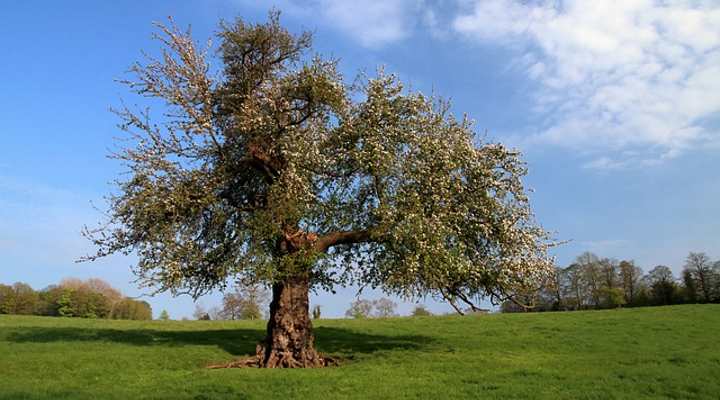
Hawthorns are flowering deciduous trees with small red fruits
Hawthorn trees are classed as small ornamental trees native to temperate regions in North America and Europe. Depending on the species, hawthorns grow between 15 and 35 ft. (4.5 – 10.5 m) tall. The trees are characterized by their spreading rounded crowns, profusion of flower clusters, and tart fruit.
Hawthorn trees are relatively slow-growing trees that live between 50 and 150 years. The attractive deciduous trees grow in wet soil and thrive in USDA zones 5 through 7. However, some species are cold-hardier. Hawthorns are often grown as specimen lawn trees or street trees.
Hawthorn Leaves
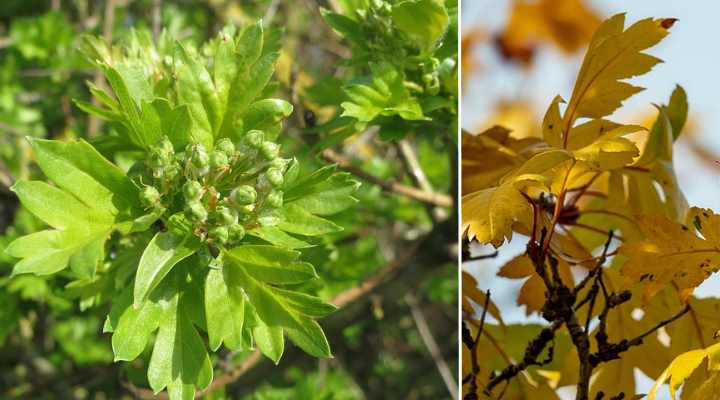
Hawthorn leaves and autumn foliage (right)
Hawthorn leaves are generally identified by deeply lobed leaves that are darker green on the upper side and pale green on the underside. Pictures of hawthorn leaves show fine tooth-like serrations on the lobed margins. Hawthorn tree leaf shape is generally ovoid, ovate, or wedge-shaped. Hawthorn leaves measure between 1” and 3” (2.5 – 7.5 cm).
Even when growing in warm regions such as Louisiana, Georgia, and Texas, hawthorn trees drop their leaves before winter. In fall, the dense deciduous foliage turns warm yellow and orange colors.
Hawthorn Flowers

Hawthorn flowers are mostly white, but some species have pink flowers
Hawthorn trees are known for their large clusters of creamy-white flowers covering the tree’s thorny branches when it’s in bloom. Hawthorn tree flowers bloom in mid to late spring, providing magnificent floral displays. Each single hawthorn flower has five petals and emits an intense, musky scent.
Hawthorn flowers grow in flat-topped, broad clusters called corymbs.
Depending on the hawthorn species, the flower cluster can be rose or pinkish-red colors. For example, flowers on the Cockspur Hawthorn (Crataegus crus-galli) and Black Hawthorn (Crataegus douglasii) are various shades of pink. But most hawthorn trees produce white flowers.
Hawthorn Fruit
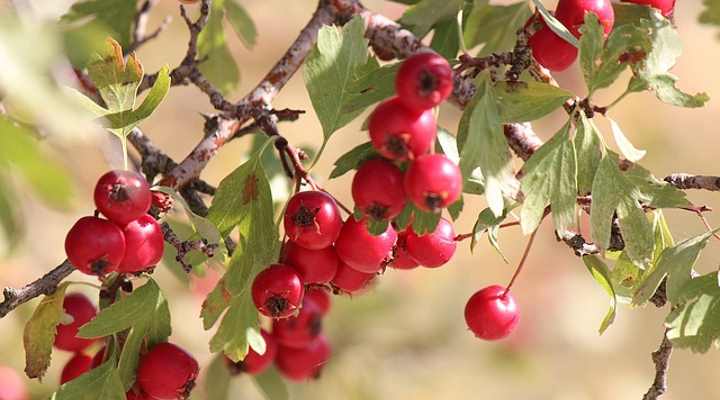
Hawthorn trees produce berry-like fruits that have tart taste
Fruit from hawthorn trees looks like clusters of small, rounded berry-like fruits that appear from fall until winter. Hawthorn fruits have thick red skin covering creamy-yellow flesh. The fleshy, tangy fruit has between one and five stones in the middle, resembling small peach or apricot stones.
Hawthorn fruits grow between 0.5” and 1” (1.2 – 2.5 cm) in diameter. The fruits are edible; however, hawthorn fruit (including mayhaws) are notoriously sour and too tangy for most people. Hawthorn jams and jellies such as mayhaw jelly are the most common way to consume these fruits.
Although hawthorn fruit is more like a pome fruit, they are generally referred to as berries. This is because the small round fruits grow in clusters like many types of berries do. Depending on the Crataegus species, the fruit can be red, yellow, blue, or orange-yellow.
Hawthorn Bark
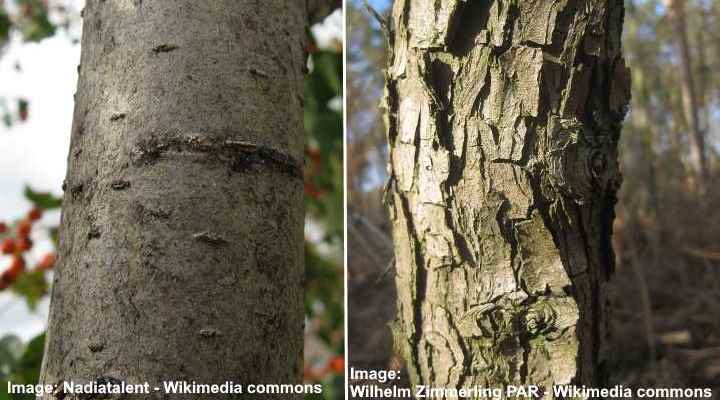
Examples of hawthorn bark. Left: Washington Hawthorn (Crataegus phaenopyrum), right: Common Hawthorn (Crataegus monogyna)
Hawthorn bark looks gray and usually has shallow fissures and narrow ridges running vertically. You can identify young hawthorn trees by the smooth, gray bark. As hawthorn matures, its bark looks like dark shades of brown that has a rough, fissured texture.
Hawthorn Tree Thorns
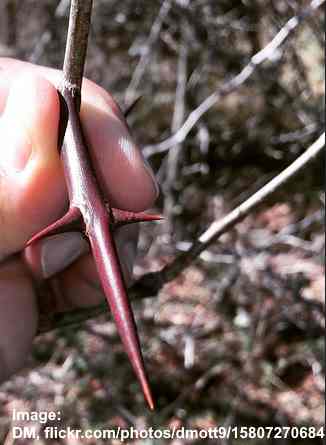
Thorns on hawthorn branch
Another way to identify hawthorn trees is by their thorny branches. The straight or curved hawthorn thorns typically grow between 1” and 3” (2.5 – 7.5 cm) long. A hawthorn’s sharp, stiff spines can do damage if you’re not careful. Damage from hawthorn thorns can result in bleeding, bacterial infections, or allergic reactions.
Hawthorn Identification
Most species of hawthorn trees look similar, and it’s difficult to tell them apart. Hawthorn species are generally identified by their broadly ovate green lobed leaves, showy clusters of spring flowers, and dangling clusters of small berry-like fruits. Hawthorns are also known for their spreading rounded to conical crown.
Types of Hawthorns (With Pictures)
Let’s look in more detail at the most common types of flowering hawthorn trees that can add beauty and color to your garden landscape.
Common hawthorn (Crataegus monogyna)
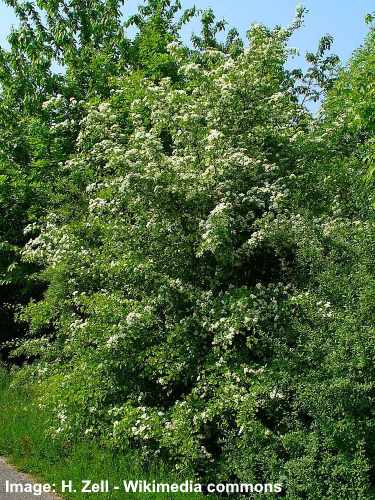
Common Hawthorn tree (Crataegus monogyna)
The common hawthorn is a small, thorny tree with lobed green leaves, white flowers growing in corymbs, and small red fruits. Also called the may blossom, the common hawthorn is a flowering shrub-like tree that grows between 15 and 45 ft. (5 – 14 m) tall. Common hawthorn trees thrive in USDA zones 5 through 7.
The common hawthorn is also known for its thorny branches. Some thorns emerge from the flower buds, and others appear at the end of the shoot. You can also tell this hawthorn species by its grayish thorny bark with thin, vertical fissures.
The common hawthorn (Crataegus monogyna) grows best in full sun or partial shade and moist, well-drained soil.
Other names for the native European common hawthorn include single-seed hawthorn, hedgerow thorn, quickthorn, and maythorn.
Hawthorn Flowers: The common hawthorn blooms with masses of creamy-white flowers with dainty pink anthers. When blooming in late spring, the flat white sprays cover most of the branches. These hawthorn flowers give off a sweet scent.

Common Hawthorn flowers
Hawthorn Fruit: The fruit from the common hawthorn are clusters of edible red berries that measure 0.4” (1 cm). The berry-like fruits look like small crabapples and are on the tree from fall until winter.
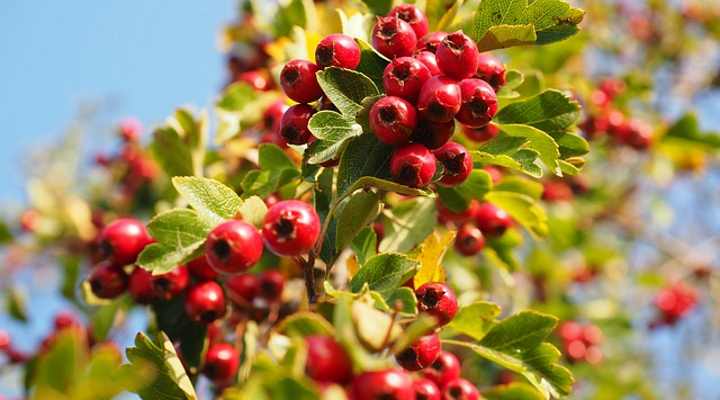
Common Hawthorn fruit and leaves
Hawthorn Leaves: The common hawthorn leaves are obovate shaped with three or four lobes on each side. The dark green leaves are lobed like some species of oak tree leaves. The leaves turn a yellowish-orange in the fall.
Washington Hawthorn (Crataegus phaenopyrum)
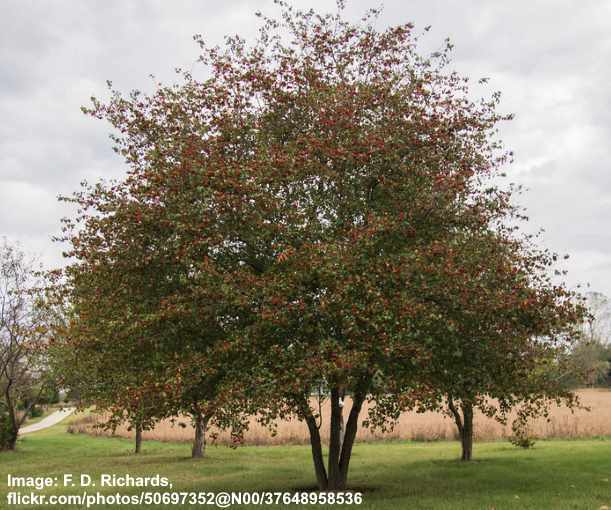
Washington Hawthorn tree (Crataegus phaenopyrum)
The Washington hawthorn is a small multi-stemmed tree with glossy green, ovate leaves, attractive white flowers, and bright red fruits. Also called the Washington thorn, this deciduous tree has a rounded crown with dense, lush foliage. Washington hawthorns grow between 20 and 25 ft. (6 – 7.5 m).
An attractive feature of the Washington hawthorn is its dark gray to brown peeling bark. As the tree ages, the bark develops a scaly appearance and falls off in flakes. This reveals an orange-red inner bark. Like most hawthorns, the bark has thorns on it.
The Washington hawthorn thrives in USDA zones 4 through 8 and is native to the U.S. This versatile ornamental landscape tree grows best in full sun. Mature trees adapt well to dry or moist soils as long as there is adequate draining.
Like most hawthorns, the Washington hawthorn has sharp spines on its branches and trunk. Its shrubby growth means you can prune the tree as a flowering privacy screen or security hedge. Its showy displays of white flowers, stunning fall colors, and red winter berries make this species a popular specimen shade tree.
Due to its attractive, showy flower displays and stunning red fall color, many people describe the Washington hawthorn as one of the most beautiful ornamental hawthorns.
Hawthorn Flowers: The Washington hawthorn is known for its masses of flat-topped clusters of white flowers. The white hawthorn tree blooms from mid-spring until mid-summer. The flowers of this hawthorn species give off an unpleasant scent.
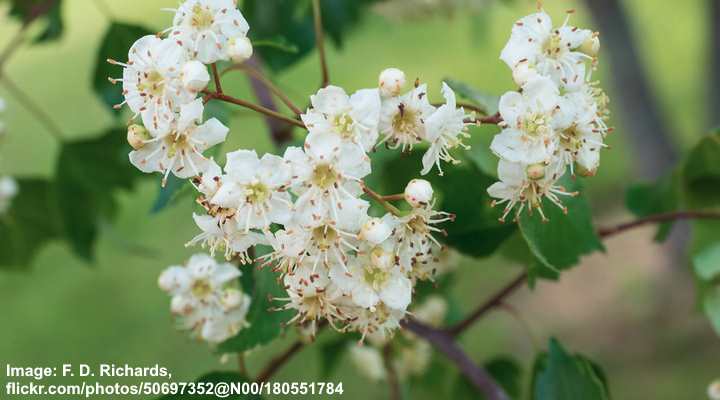
Washington Hawthorn flowers
Hawthorn Fruit: The fruit from the Washington hawthorn are small bright red pome clusters appearing from September until November. The glossy berry-like fruits measure up to 0.2” (0.5 cm) wide and have a tangy taste.
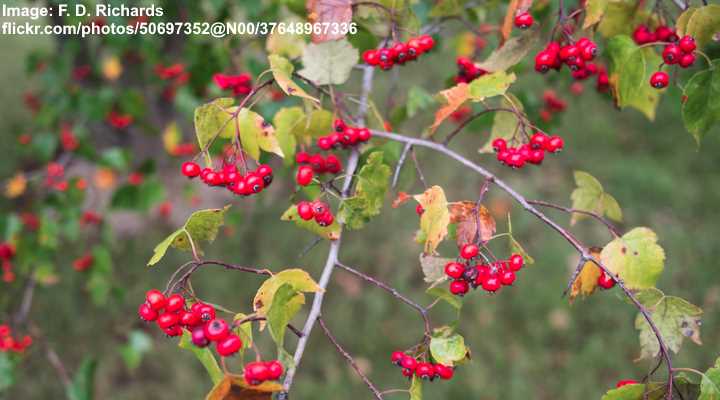
Washington Hawthorn berries and leaves
Hawthorn Leaves: Washington hawthorn leaves are triangular or ovate shaped and grow 1” to 3” (2.5 – 7.5 cm) long. The lobed leaves have an appearance of small maple leaves. The leaf margins are serrated and have a simple, alternate arrangement on thorny branches. The fall color of Crataegus phaenopyrum is shades of bright red, purple, and orange.
English hawthorn (Crataegus laevigata)
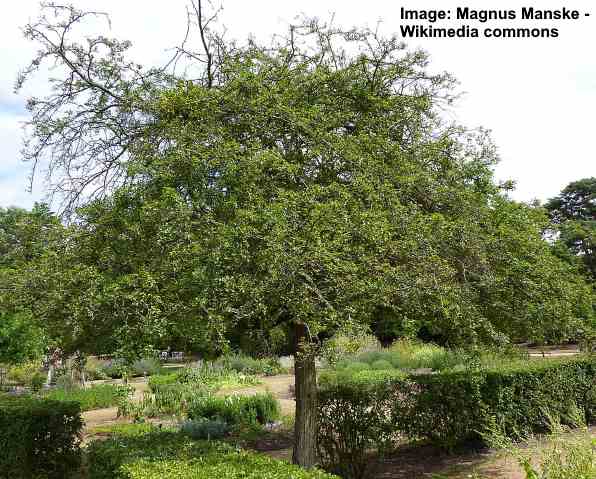
English Hawthorn (Crataegus laevigata ‘Punicea’)
The English hawthorn is a large flowering shrub or small tree with shiny green lobed leaves, masses of pale pink or white flower clusters, and bright or dark red round fruits. Also called the woodland hawthorn or mayflower, Crataegus laevigata grows up to 26 ft. (8 m) tall. The decorative tree grows best in moist, well-draining soils.
Native to Europe, the English hawthorn thrives in USDA zones 5 through 8.
Other common names for the English hawthorn tree are the smooth hawthorn, Midland hawthorn, and quickset thorn.
Hawthorn Fruit: The fruit from English hawthorn trees are red berry-like pomes that grow in dense clusters. Each small flattened round fruit measures between 0.2” and 0.4” (0.6 – 1 cm).
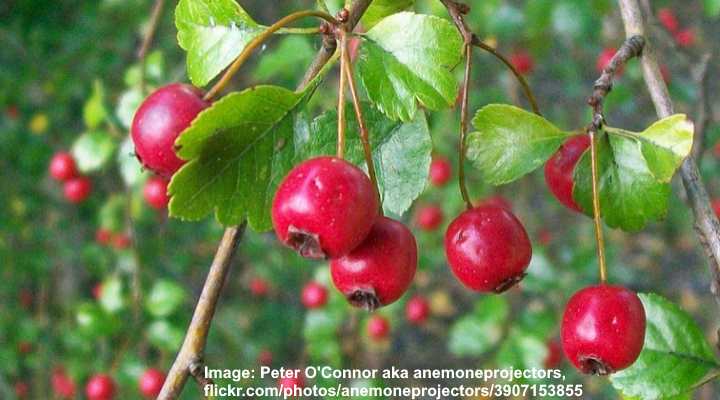
English Hawthorn fruit
Hawthorn Flowers: The English hawthorn’s spring blossoms cover branches with beautiful 5-petaled flowers. The flat-topped corymbs of pale pink or white flowers resemble apple or cherry blossoms.
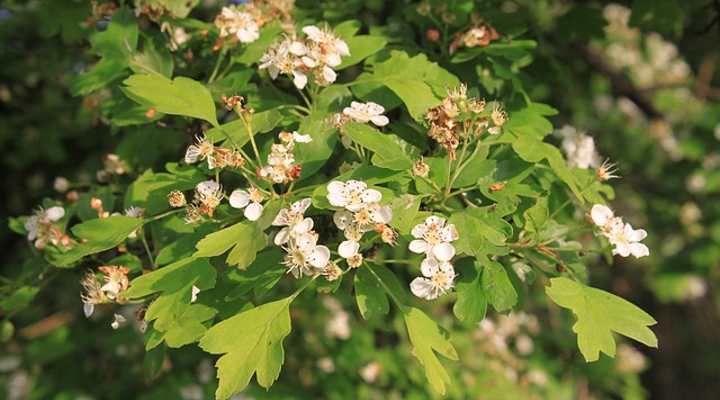
English Hawthorn flowers and leaves
Hawthorn Leaves: The English Hawthorn has glossy green ovate leaves with three to five lobes. Leaves are arranged alternately and measure between 1” and 3” (2.5 – 7.5 cm). English hawthorn leaves don’t have any significant fall color.
Cockspur hawthorn (Crataegus crus-galli)
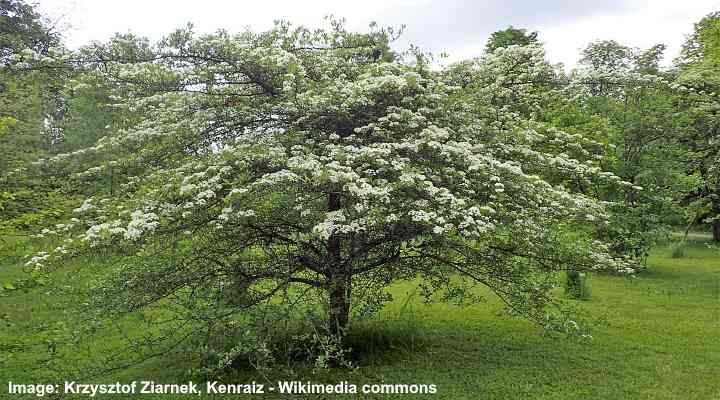
Cockspur Hawthorn tree (Crataegus crus-galli)
The cockspur hawthorn is a small deciduous shade tree or shrub with unlobed, serrated-edged leaves, spectacular white flowers, and red apple-like fruits. This hawthorn species grows between 15 and 35 ft. (4.5 – 10 m) with a rounded, pyramidal shape. It has light gray, smooth bark with slight fissuring.
Like most hawthorns, the cockspur hawthorn has showy, fragrant white flowers. The flowers bloom in spring and give off a pleasant scent that gradually becomes an unpleasant fishy stench.
The Crataegus crus-galli hawthorn species is identifiable by its ovate, glossy, green leaves up to 3” (7.5 cm) long. Unlike other hawthorn trees, the leaves of this species don’t have lobes. The leaves turn various shades of red, orange, and purple in the fall.
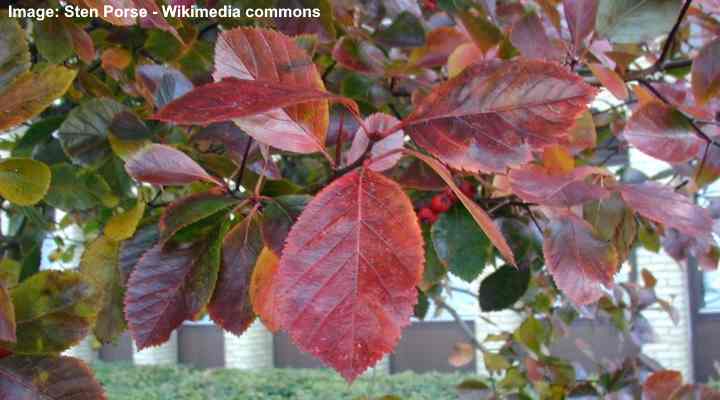
Cockspur Hawthorn leaves in autumn
Another feature of the cockspur hawthorn is its huge, long thorns. The stiff spines can measure up to 4” (10 cm) long.
Thornless cockspur hawthorn (Crataegus crus-galli var. inermis)
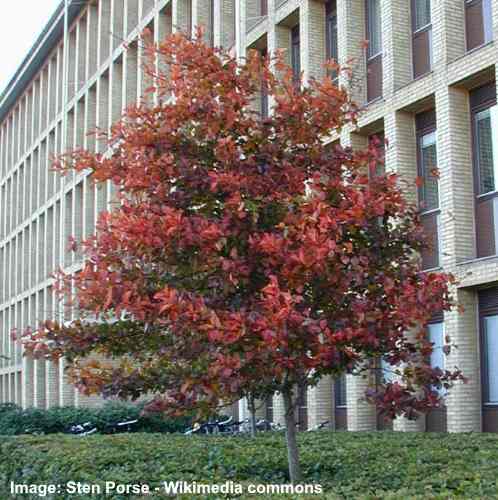
Thornless Cockspur Hawthorn tree (Crataegus crus-galli var. inermis)
The thornless cockspur hawthorn tree has the typical identifying features of hawthorns—dense foliage, white flower clusters, and red berries. However, the Crataegus crus-galli var. inermis is unique because it’s a thornless hawthorn variety. You can safely plant this tree in your yard without fear of damage from the thorns.
The thornless cockspur hawthorn thrives in full sun and most types of moist soils. The shrubby tree grows between 20 and 30 ft. (6 – 9 m). However, with regular pruning, you can limit its height. Depending on your landscaping needs, you can grow this hawthorn species as a flowering hedge, privacy screen, or specimen tree.
Chinese Hawthorn (Crataegus pinnatifida)
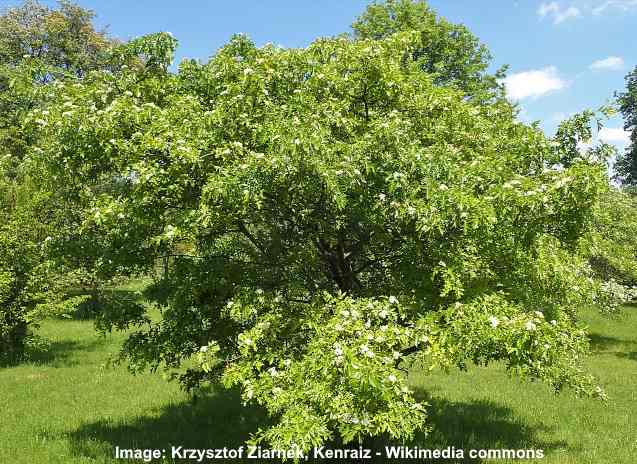
Chinese Hawthorn tree (Crataegus pinnatifida)
The Chinese hawthorn is a small shrub-like tree with lobed green leaves, white flower clusters growing as corymbs, and large globular fruits. Chinese hawthorns grow between 15 and 23 ft. (4.5 – 7 m) tall. This low-maintenance tree species has thin gray bark and an irregular, rounded crown.
This identifying feature of the Chinese hawthorn is its large red, edible, apple-like fruits. In Chinese, the tree’s name means “big red fruit,” and the red fruit clusters are some of the largest hawthorn fruits.
Chinese hawthorn leaves are ovate-shaped, with pointed, lobed margins. The leaves grow between 2” and 4” (5 – 10 cm) long and form a dense canopy on the tree. Like most hawthorns, the white corymbs transform the tree into a mass of white flowers during spring.
Black hawthorn (Crataegus douglasii)
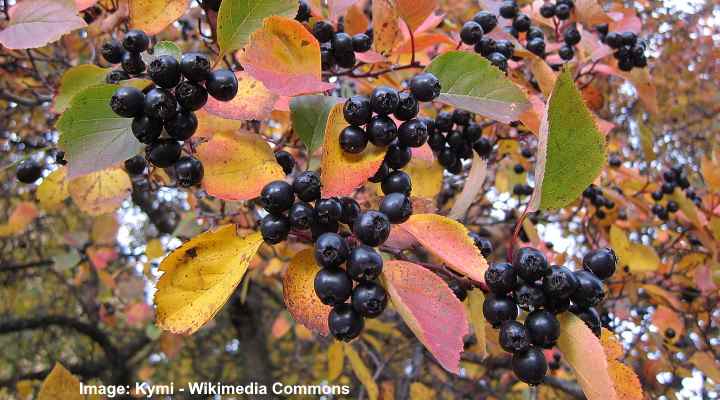
Black hawthorn (Crataegus douglasii) leaves and fruit
The black hawthorn is a compact thorny shrub or tree with fan-shaped serrated leaves, white flowers, and dark purple almost black fruits. As an ornamental landscape tree, the black hawthorn has a rounded crown of spreading branches. The black hawthorn grows between 10 and 25 ft. (3 – 8 m) tall and wide.
This hawthorn is known for its glossy, leathery leaves that create a canopy of dense foliage for shade. In fall, the hawthorn leaves turn shades of orange, yellow, or red. Then clusters of bright dark purple or black fruits appear to add color to barren fall and winter landscapes.
The black hawthorn has a natural shrubby growth, making it an ideal hedge plant for a privacy screen or security barrier.
Mayhaw Tree Varieties (Crataegus opaca and Crataegus aestivalis)
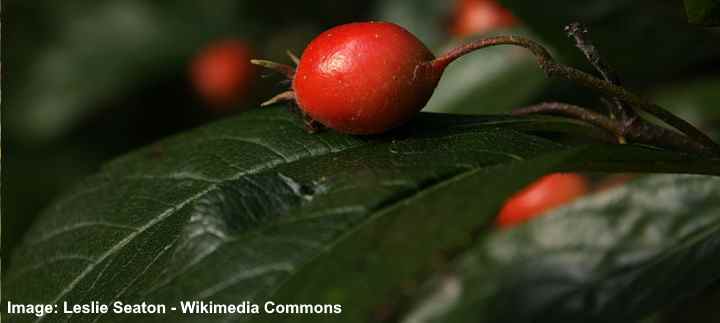
Mayhaw tree fruits are used to make jellies and jams
The two popular types of mayhaw trees—Crataegus aestivalis and Crataegus opaca—grow in swampy areas in the southeastern U.S. Mayhaw trees grow between 12 and 36 ft. (4 – 11 m) and have clusters of pinkish-white flowers and bright red fruits.
The common name of these hawthorn species – mayhaw – is from the fact that the large berry-like fruits or mayhaws ripen in May. Because they are too sour to eat, the mayhaw fruits are collected and used to make mayhaw jellies, preserves, and jams. This sweet yet tangy condiment has a rosy-red color and is popular in southern states.
The Western hawthorn (Crataegus opaca) has oval, dark glossy green leaves, white or pink flowers, and clusters of red apple-like mayhaws.
The May hawthorn (Crataegus aestivalis) has wedge-shaped, lobed green leaves with toothed margins. The white flowers grow singularly or in small clusters. The burgundy-colored mayhaw fruit grows up to 1” (2.5 cm).
How to Plant Hawthorn Trees
Hawthorn trees are easy to grow in most garden landscapes. The versatile ornamental trees adapt well to various types of soil. Most species of hawthorn trees thrive in moist soils; however, they are relatively drought-resistant plants when established.
Hawthorn trees grow best in full sun, and they will tolerate some shade. If you have children in the garden, then it’s best to plant thornless hawthorns. The thorny varieties are excellent shrubs for privacy screens or security hedges. Growing as a small tree, hawthorns are attractive specimen trees for lawns.
Related articles:
